30+ Best Brazilian Foods (And Where To Find Them)
READY TO EAT SOME OF THE FAMOUS BRAZILIAN DISHES?
Brazil may not be well known on the global culinary scene, but for those in the know, the country has some real gastronomic gems.
I love Brazilian food, and I always end up appreciating it more than ever when I visit my family and friends in Canada — I especially miss pão de queijo, brigadeiro, and all the delicious fruits!
Before I came to Brazil, I’d imagined that as a tropical country, it would be all about salads, seafood, and light, fluffy bread. Yet that couldn’t be further from the truth. Here, food feeds the soul, warms the cockles, and has a real homely feel.
Here are 30 foods that you really should try when you’re in Brazil (you’ll love them!) and some of my favorite spots to find them in Rio de Janeiro
Best Brazilian Food: Appetizers, Petiscos & Side Dishes
BEST BRAZILIAN FOOD
Pastels
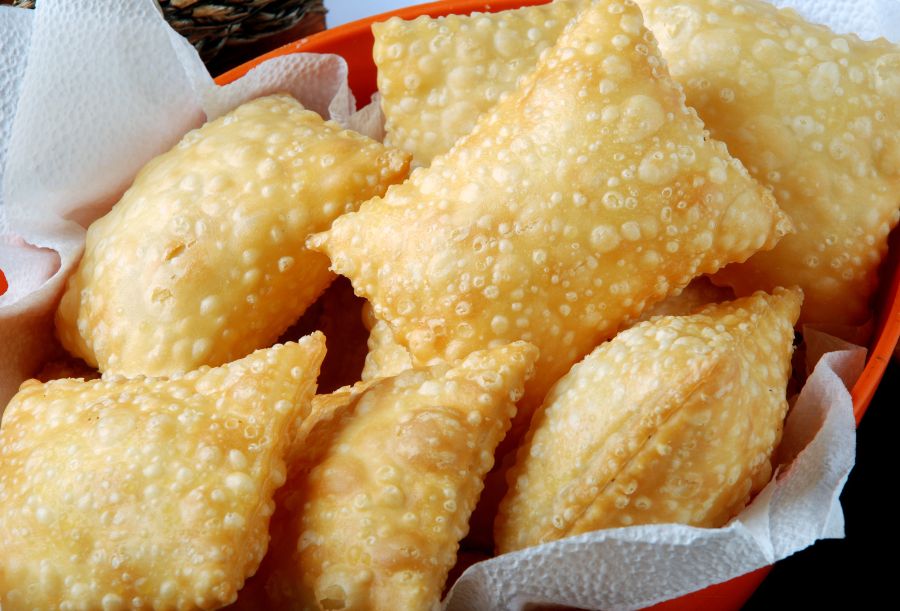
Pastels are typically served in two ways – either as large, rectangular pastels (known as pastel de vento or ‘windy pastel’) found at the farmers’ market or as small, half-moon-shaped pastels commonly found at bars.
Popular fillings include minced meat, cheese, pizza (cheese, tomato, and oregano), heart of palm, chicken, and prawns.
My favorites are the ones from the farmers’ markets (click here to see some of the best ones) served with chilled sugar cane juice. For bar pastels, one of the best is Bar do Adão in Lapa which has unusual fillings on the menu, such as apricot and brie, alongside more traditional options.
BEST BRAZILIAN FOOD
Pão de Queijo
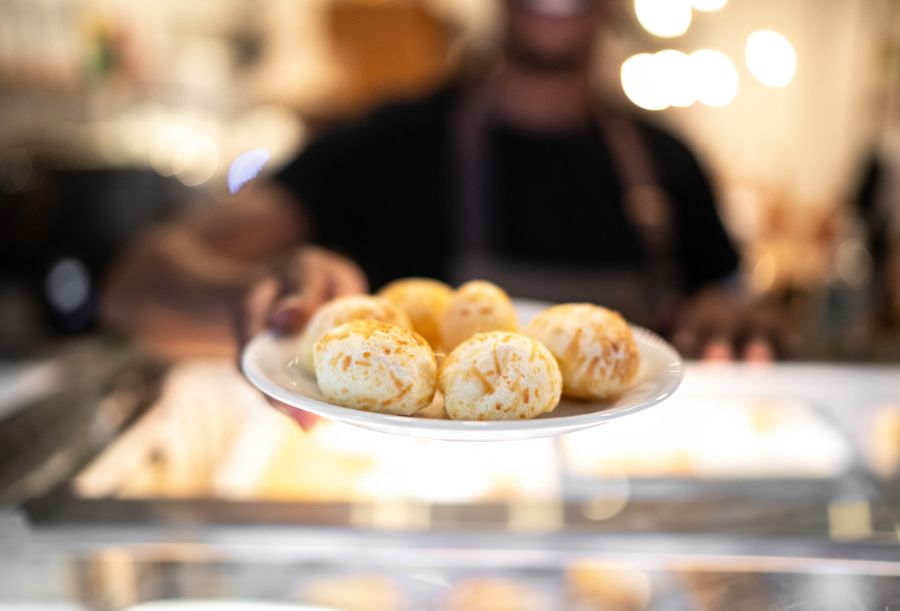
This is, hands down, one of my favorite go-to Brazilian snacks. Pão de Queijo, also known as “cheese bread,” is a gluten-free Brazilian snack.
The main ingredients in Pão de Queijo are cassava flour (also known as tapioca flour) and queijo de Minas or queijo de Canastra meia-cura – which is similar to Monterey Jack or mozzarella. The result? A delightful combination of crispiness on the outside and a soft, cheesy interior.
Most Brazilians eat pão de queijo as a snack or for breakfast – often with sweet or even savory accompaniments. For a great pão de queijo, try Cultivar in Santa Teresa, a venue that sells and produces organic products whenever possible.
BEST BRAZILIAN FOOD
Coxinha
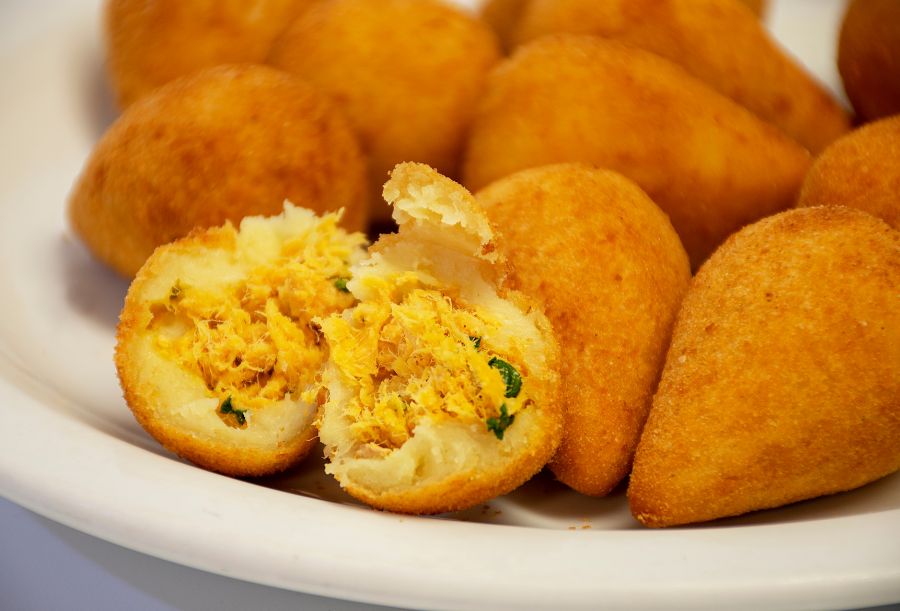
Coxinha, a beloved Brazilian street food, has its roots in the state of São Paulo. Originally, it was a creative solution to avoid wasting food, turning leftover chicken into a delicious snack.
A coxinha is a teardrop ball of gooey dough wrapped around shredded chicken before being covered in breadcrumbs and deep-fried. It’s a substantial snack, although probably not one to eat every day. Some also come with cream cheese mixed with the chicken.
Fornalha has both traditional and cream cheese coxinhas with branches in both Botafogo and Copacabana. Another place worth checking out for its great coxinhas is the Portuguese-colonial-style restaurant Casa Cave in Centro.
BEST BRAZILIAN FOOD
Joelho

For a bite of something filling and homely, try a joelho. The joelho – which literally means ‘knee’ in English – is a thick, bread-like pastry with ham and cheese inside.
The best places in Rio for a joelho are the juice stores dotted throughout Copacabana, Ipanema, and Leblon. I’ve already recommended it for the coxinha, but Fornalha also does a great joelho too.
BEST BRAZILIAN FOOD
Misto Quente
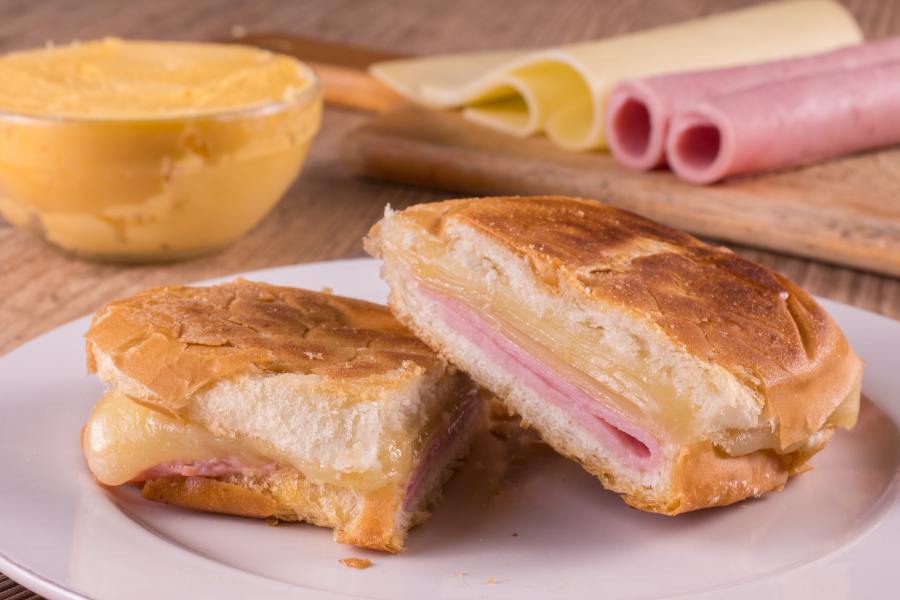
Misto quente is basically toasted French bread with ham and melted cheese inside, yet its beauty lies in its simplicity. It’s my easy, go-to snack almost every time and is perfect with freshly squeezed fruit juice. They are easy to find – all the fruit juice bars throughout the city sell them.
BEST BRAZILIAN FOOD
Kibe
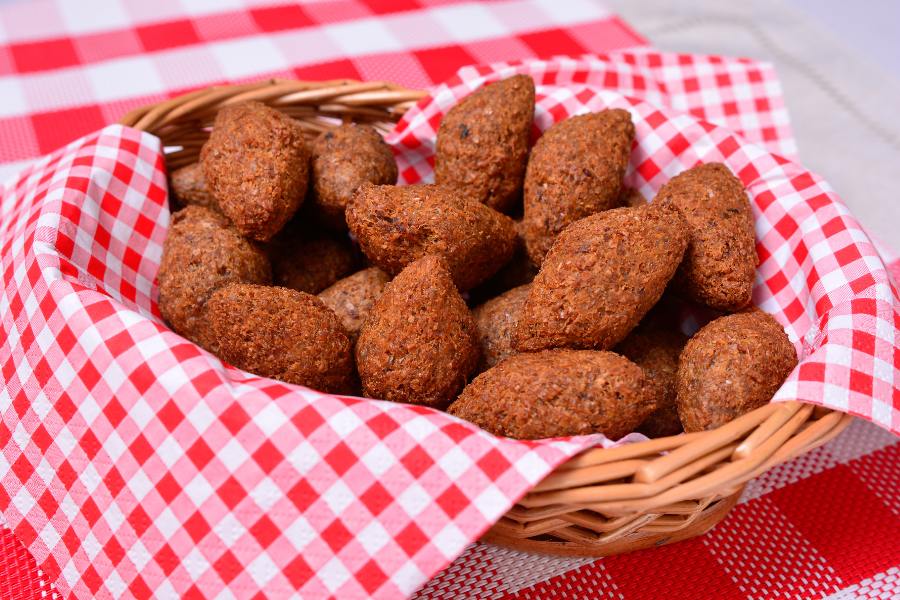
Kibe, a popular snack in Brazil, is a football-shaped deep-fried croquette made from a mixture of ground beef, bulgur wheat, and an array of flavorful seasonings, like garlic, onions, mint, and cinnamon.
While its origins can be traced back to Lebanon, where it is traditionally prepared using ground lamb, in Brazil, it is commonly made with ground beef. Kibe is often enjoyed as an appetizer, served alongside a variety of condiments and dips like tahini or yogurt sauce.
⭐️ Fun fact, the dish made its way to Brazil through Arab immigration during the late 19th century, where it has become an integral part of Brazilian cuisine.
BEST BRAZILIAN FOOD
Empada
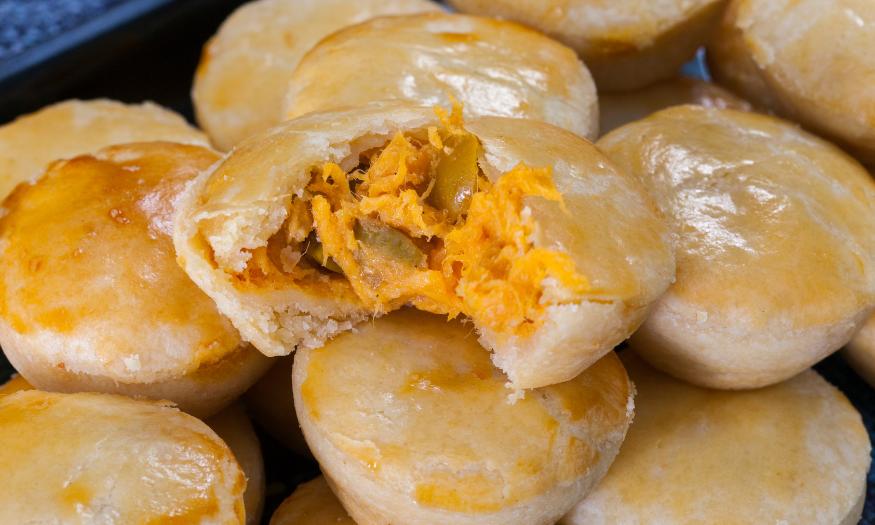
Empadas are mini pies with fillings such as carne seca (dried meat), prawns and Catupiry, shredded chicken, and heart of palm. They come best served with a chilled chopp (Brazilian beer) on a balmy Rio evening.
My favorite empadas are at Belmonte, where they come with a small pastry base, and heaps of carne seca piled on top. Every time I go there, whether I’m hungry or not, I can’t resist ordering one of these bad boys.
BEST BRAZILIAN FOOD
Bauru Sandwich

The Bauru sandwich is a popular Brazilian dish named after the city of Bauru in São Paulo state. It was invented in the 1930s by a law student named Casemiro Pinto Neto, who was known by his nickname, Bauru.
Pinto Neto walked into a bar and, tired of the usual menu options, requested the cook to prepare a sandwich according to his specifications. The result was a sandwich made of French bread, sliced roast beef, tomato, pickles, and melted cheese – a combination that was a hit among the patrons.
The Bauru sandwich became so popular in the region that it started being replicated in other bars and restaurants across Brazil. Today, it’s a common find in lanchonetes, the Brazilian equivalent of diners, and is enjoyed as a hearty lunch or dinner option.
BEST BRAZILIAN FOOD
Tapioca Crepe
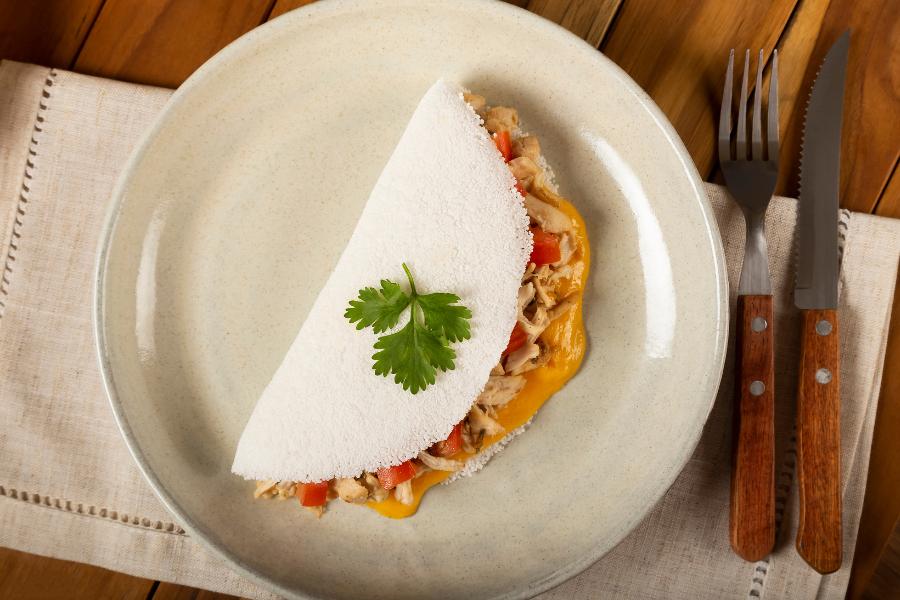
The tapioca pancake was a typical food from the northeast of Brazil, yet has grown in popularity for its health properties – it’s a gluten-free option that is relatively low in calories.
It can be eaten savory with cheese, tomato, and ham or sweet with chocolate, strawberries, banana, and sprinkles of nuts. The best places to buy them are the little mobile stalls that are dotted along the beach in Copacabana or in the city center near metro Carioca.
BEST BRAZILIAN FOOD
Acarajé

Acarajé is a popular street food originating from Bahia state. These treats feature deep-fried balls of black-eyed pea dough, crispy on the outside and soft on the inside. The uniqueness of acarajé lies in its flavorful fillings, which include ingredients like shrimp, vatapá (a shrimp and peanut sauce), and caruru (a spicy ok
Historically, acarajé is associated with Afro-Brazilian cuisine, reflecting the culinary traditions brought by West African slaves. It has since become an integral part of Bahian culture and the street food scene.
In Rio de Janeiro, there are a variety of Bahian restaurants that you can visit, but if you’d like to try Acarajé, one of the best places is the Sunday Hippie Fair which takes place in General Osario. On one of the corners is a Bahian food stall where you can order Bahian favorites, like acarajé.
Best Brazilian Food: Main Dishes & Side Dishes
BEST BRAZILIAN FOOD
Feijoada Completa – The National Dish of Brazil

Feijoada is a traditional black bean Brazilian stew that is believed to have originated during the time of slavery in Brazil. The dish was created using inexpensive ingredients readily available to slaves, such as black beans, pork, and various cuts of meat.
Feijoada (also known as Brazilian beef stew) typically includes black beans cooked slowly with a variety of meats, including smoked pork sausage, bacon, and cuts of pork like ribs and pork shoulder. In Bahia, red or brown beans are used. This Brazilian black bean stew is often seasoned with garlic, onions, and spices and served with white rice, collard greens, farofa — toasted cassava flour — and orange slices.
It is traditionally served on Saturday afternoons or during Sunday lunch and is intended to be a leisurely (but hearty) midday meal. The best place to have a Saturday feijoada is in the Santa Teresa neighborhood, I’ve always enjoyed eating at Bar do Mineiro.
BEST BRAZILIAN FOOD
Brazilian Churrasco
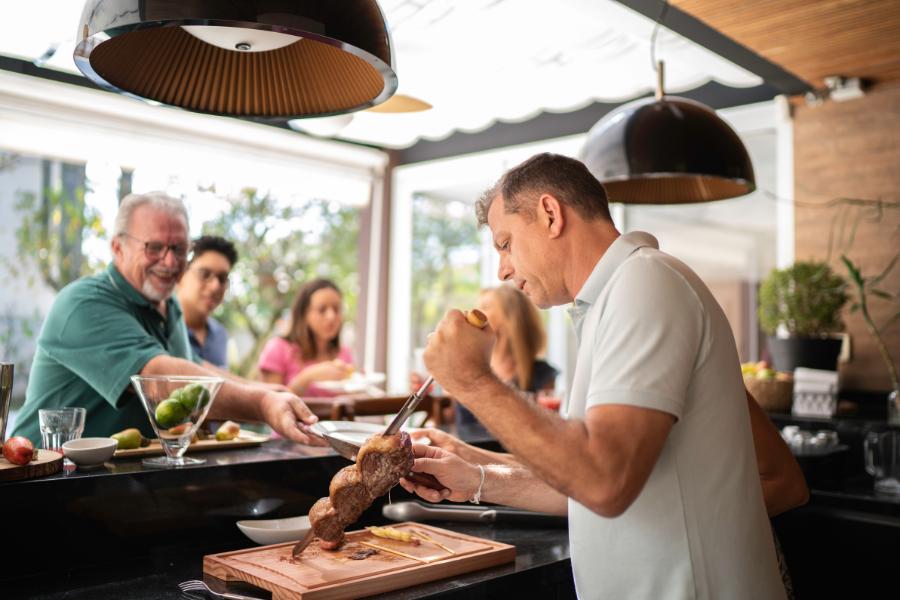
Churrasco, Brazil’s version of barbecue, is deeply embedded in the country’s culinary and cultural traditions. This style of cooking meat originated in the Pampas region, an area that includes the southern state of Rio Grande do Sul and extends into Uruguay and Argentina.
It started with the gaúchos, South American cowboys, who would prepare meals over an open fire during their cattle drives. They would skewer large pieces of meat (like picanha skewers) and slow-roast them over a wood or charcoal fire, resulting in a tender, flavorful feast.
Today, churrasco (or Brazilian barbecue) is a staple in many Brazilian celebrations and social gatherings. Different types of meat, including beef, pork, and chicken (including Brazilian chicken hearts), are seasoned with just coarse salt before being grilled to perfection. The meal is typically served with Brazilian side dishes like rice, farofa, and vinaigrette sauce.
You eat Brazilian favorite at a churrascaria, and my favorite churrascaria in Rio de Janeiro is Fogo de Chão Botafogo. It is a little pricey, but the view and the delicious food are well worth it.
BEST BRAZILIAN FOOD
Picaña steak

Picanha steak, a prized cut of beef, is a fixture in Brazilian barbecue culture, known as churrasco. The name ‘Picanha’ derives from the word ‘picana’, which was a pole used by ranchers in the southern parts of Portugal and Spain to herd cattle, pointing to the cut’s origin.
The Picanha Brazilian meat is the rump cap, characterized by its fat cap that adds to the depth of flavor when grilled. It’s traditionally skewered in a C-shape and grilled over open flames, a method that renders the fat and imparts a rich, smoky flavor to the meat.
Simple seasonings like coarse salt are often all that’s used to enhance the natural flavors of this delectable cut. Again, I would recommend eating picanha at a churrascaria, and I’d recommend Fogo de Chão Botafogo.
BEST BRAZILIAN FOOD
Farofa
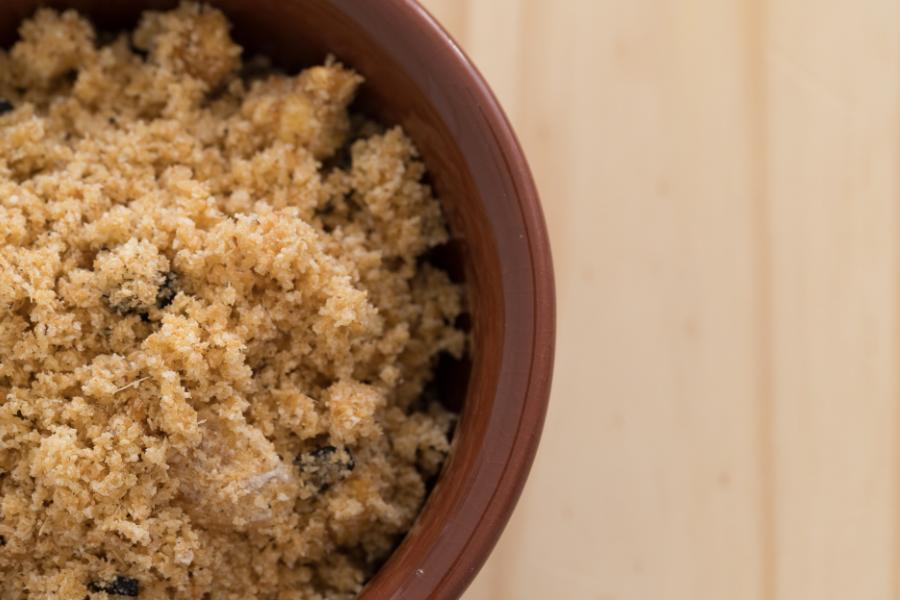
Farofa is a quintessential Brazilian side dish that originates from the indigenous tribes of Brazil. This simple dish was created as a means to use manioc flour, a staple ingredient available across the country.
To make farofa, manioc flour is toasted in a pan with butter, oil, or bacon fat until it becomes golden brown and crispy. Other ingredients, such as eggs, bacon, onions, and parsley, are often added to enhance flavor, but the base remains the same.
It is served with a wide range of dishes, most notably feijoada, Brazil’s national dish. Go to any restaurant, bar or boteco that serves traditional Brazilian meals with beans and rice to try farofa.
BEST BRAZILIAN FOOD
Escondidinho

Escondidinho, translating to “little hidden one,” is a classic dish from the Northeast of Brazil, specifically from the state of Pernambuco. It’s a product of resourceful Brazilian cuisine, crafted from locally available ingredients.
This casserole-like dish is made by layering sun-dried meat or shredded chicken under a creamy mound of mashed cassava, often finished with a generous sprinkle of cheese. Once baked, it offers a deeply comforting and hearty meal, combining the diverse textures and flavors of its ingredients. The name itself refers to the hidden layer of meat beneath the cassava, a surprise that adds to the charm of this beloved Brazilian dish.
BEST BRAZILIAN FOOD
Baião de Dois (Beans and Rice)
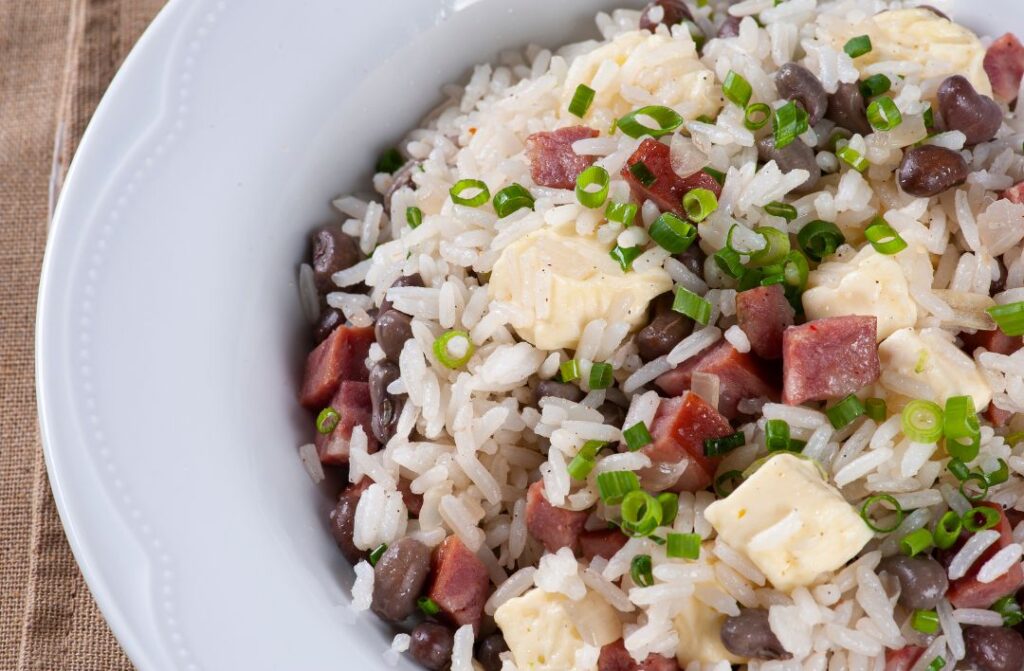
Baião de Dois is a traditional dish from the Northeast region of Brazil, particularly popular in the states of Ceará and Rio Grande do Norte. It’s believed to have been created by the region’s rural workers, who needed hearty meals for their physically demanding tasks.
This flavorful dish is a combination of rice and black eyed peas, cooked together with various ingredients like cheese, dried meat, and sautéed onions. The result is a creamy, hearty meal that’s both nourishing and comforting.
BEST BRAZILIAN FOOD
Moqueca
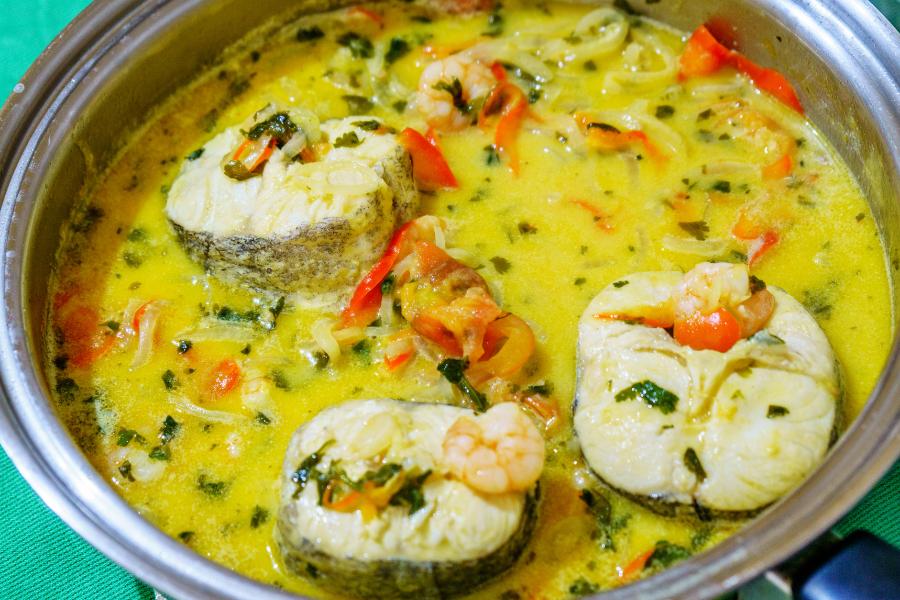
Moqueca is a Brazilian seafood stew that combines palm oil or olive oil with coconut milk, along with fish, shrimp, or both. This delicious dish is slow-cooked in traditional clay pots with vegetables and fresh herbs and served over rice.
The origins of this dish go back 300 years and are a result of Portuguese, indigenous, and African influences. Although many of you will end up trying moqueca baiana, there are actually many different ways to prepare moqueca. The three main types are Moqueca Baiana, Moqueca Capixaba, and Moqueca Paraense.
BEST BRAZILIAN FOOD
Vatapá

Vatapá has its roots deep in Afro-Brazilian culture, introduced by African slaves who made the best use of the limited ingredients available to them. Its roots are traced back to the state of Bahia, a region renowned for its African-influenced cuisine.
The dish is a blend of bread, dried shrimp, coconut milk, finely ground peanuts or cashews, palm oil, and a fusion of spices. Vatapá started as an affordable dish for the lower classes, and over time, it has gained popularity across all segments of Brazilian society. It’s a true testament to the power of culinary creativity.
BEST BRAZILIAN FOOD
Bobó De Camarão

Bobó de Camarão is a rich and creamy shrimp stew that hails from the Bahia region in the Northeast of Brazil. The Bahian cuisine is heavily influenced by African, Indigenous, and Portuguese culinary traditions, and Bobó de Camarão reflects this vibrant fusion.
The main components of this dish are fresh shrimp that are enveloped in a thick, velvety puree made from manioc (also known as cassava or yuca) and coconut milk. The stew is often seasoned with palm oil, onions, tomatoes, garlic, and coriander, delivering a robust combination of flavors.
BEST BRAZILIAN FOOD
Carne Seca

Carne de Sol, or sun-dried meat, is a popular dish from the Northeast of Brazil, a region known for its arid climate. This preservation method was born out of necessity at a time when refrigeration was not widely available.
Traditionally, the meat is salted and left under the sun to dry for one or two days, which preserves it and adds a unique flavor. Nowadays, the drying process usually takes place in the shade to maintain better control over the drying conditions.
The dish is often served with a side of green beans, rice, and farofa. Sometimes, a slice of grilled queijo coalho, a cheese that doesn’t melt easily, is served on top for an extra touch of flavor. It can also be served with aipim frito and butter.
BEST BRAZILIAN FOOD
Mandioca Frita
I love these, and they usually feature as my go-to snack at botecos on a night out. They are the Brazilian alternative to chips and are deep-fried cassava sticks. They are also perfect as Brazilian appetizers or side dishes.
I love them with a pouring of melted butter and a few drops of chili oil. There are so many botecos in Rio that sell great mandioca, yet I really love the one in Feria Nordestina in Sao Cristóvão.
Best Brazilian Food: Drinks
BEST BRAZILIAN FOOD
Caldo de cana

Caldo de Cana, or sugarcane juice, is a traditional Brazilian drink that dates back to the colonial period when sugarcane plantations were a major part of Brazil’s economy. Today, Brazil is still the largest sugarcane exporter in the world.
The process of making Caldo de Cana is fairly straightforward. Fresh sugarcane stalks are pressed through a machine, extracting a sweet, greenish juice that is both refreshing and energizing. It is often served with a squeeze of lime to balance the sweetness.
My favorites are the ones from the farmers’ markets (click here to see some of the best ones) served with pastels.
BEST BRAZILIAN FOOD
Caipirinha
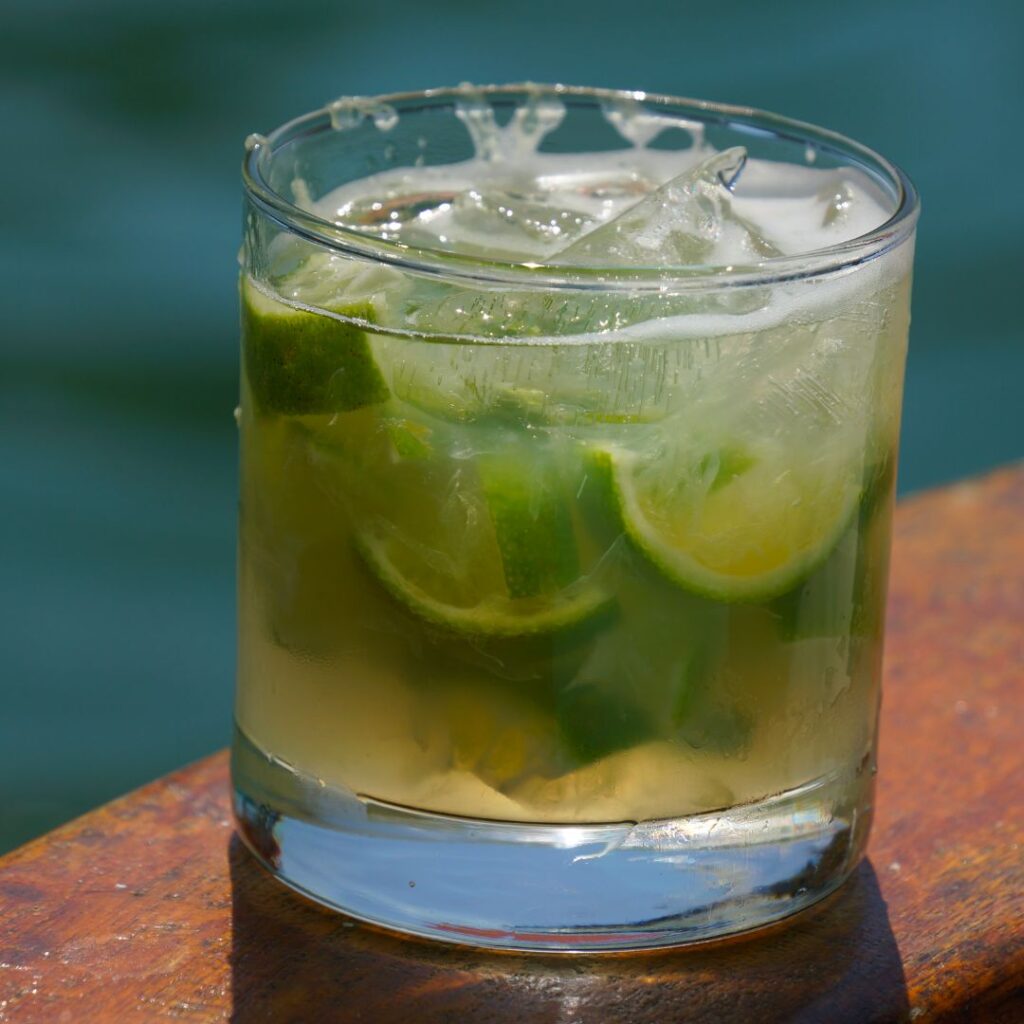
Caipirinha, Brazil’s national cocktail, hails from the state of São Paulo. The drink’s creation dates back to the early 20th century and was initially used as a remedy for the Spanish flu, with its ingredients thought to help alleviate symptoms.
This renowned cocktail is made with cachaça, a Brazilian spirit derived from sugarcane juice, fresh lime, sugar, and crushed ice. The ingredients are muddled together and served in a short glass, delivering a refreshing balance of sweet, sour, and strong flavors.
One of the best caipirinhas that I have had was when I took a food tour through the streets of Rio de Janeiro. We ended up in Centro and had some amazing caipirinhas at LaButa Bar. Although you can get these iconic drinks just about everywhere in Rio.
Best Brazilian Food: Desserts
BEST BRAZILIAN FOOD
Canjica

I love canjica, and I ate it for breakfast every day when I was in Poco de Caldas in Minas Gerais. It’s soft, white corn mixed with coconut milk, condensed milk, and a sprinkling of cinnamon on top. The recipe varies slightly depending on who you talk to, but the result is pretty much the same.
One variation is canjica com amendoim, which is the same recipe, just with peanuts added (it’s amazing). Empório Jardim in the Jardim Botânico neighborhood has a smooth and creamy canjica com amendoim on its menu.
BEST BRAZILIAN FOOD
Brigadeiro

Brigadeiros are balls of truffle made from condensed milk and cacao powder before being covered in chocolate sprinkles. They are so simple, yet are one of my favorite Brazilian sweets.
Some stores have done their own gourmet takes on the Brigadeiro dessert traditional recipe with additions such as pistachio nut coverings or a strawberry inside the truffle.
BEST BRAZILIAN FOOD
Beijinho De Coco

Beijinho de Coco, affectionately known as “little coconut kiss,” is one of the most cherished Brazilian desserts, originally influenced by Portuguese cuisine. This bite-sized sweet is typically served at children’s birthday parties and other festive events.
It is made with a blend of condensed milk, grated coconut, and butter. After cooking, the mixture is cooled, then formed into small balls, rolled in more coconut, and each is topped with a clove. Catarina Doces e Salgados in Copacabana has wonderful beijinhos de coco.
BEST BRAZILIAN FOOD
Açai

Açaí is a great post-beach snack, and I love the refreshing taste on a hot summer’s day. Personally, I love it mixed with granola, but it’s also good with strawberries and bananas with a drizzle of honey on top.
Once again, Cultivar in Santa Teresa makes the list for having the quasi-official title of the best açaí in town.
BEST BRAZILIAN FOOD
Biscoito Globo
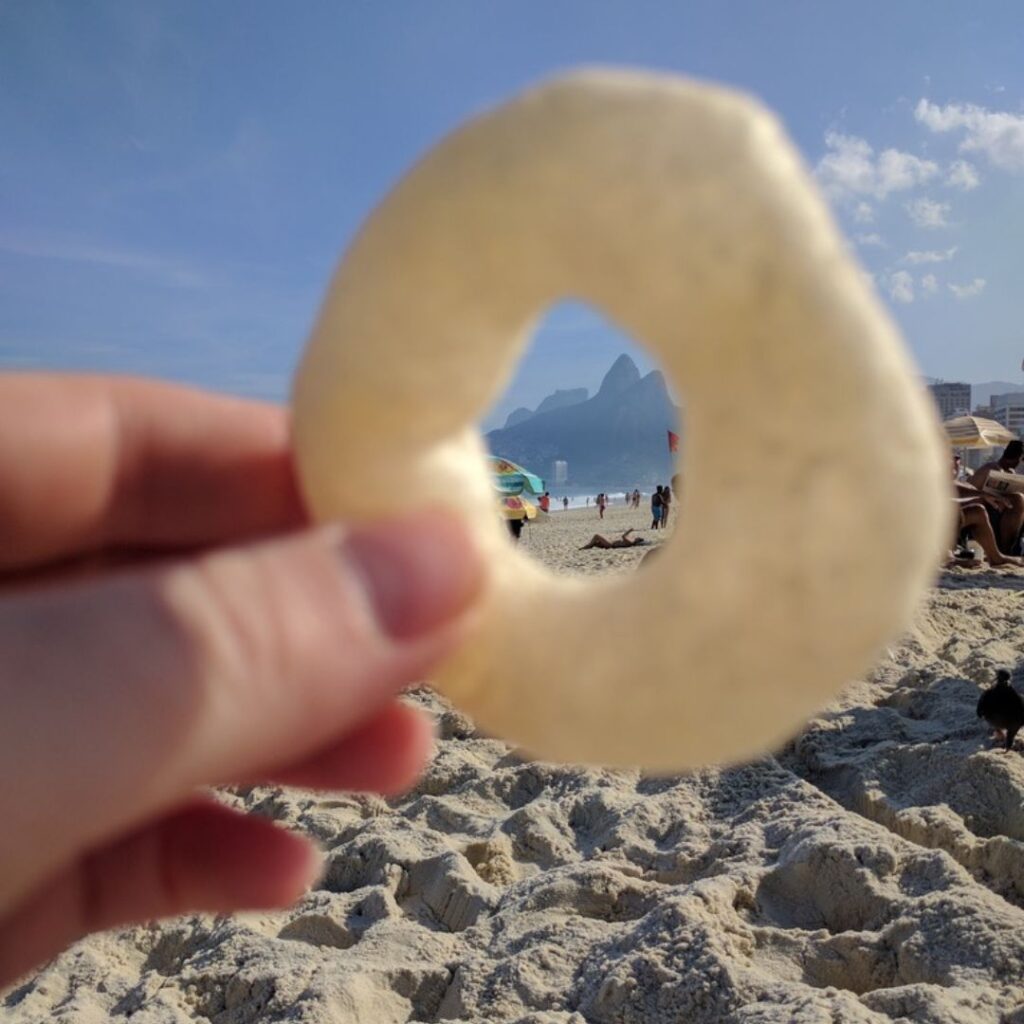
Biscoito Globo has a place among Rio’s cultural icons and brings about a certain nostalgia in Cariocas (people from Rio de Janeiro). Made with manioc flour, they are crunchy, airy crisps with a distinct taste that is incomparable.
Despite their simplicity, they are incredibly moreish and are a tasty savory accompaniment to an ice-cold mate. The best place to buy them is from the beach vendors at Copacabana, Ipanema, and Leblon Beach.
BEST BRAZILIAN FOOD
Romeu e Julieta

This combination of guava jelly-like paste and mild, white cheese just works on so many levels. It is sometimes eaten as the main flavor for a cheesecake, in a pastel, in an empada, or simply on its own.
Head to Talho Capixaba in Leblon to get a fresh croissant with Romeu e Julieta on the inside. It’s delicious and is best served with one of the coffee shop’s excellent coffees.
BEST BRAZILIAN FOOD
Quindim
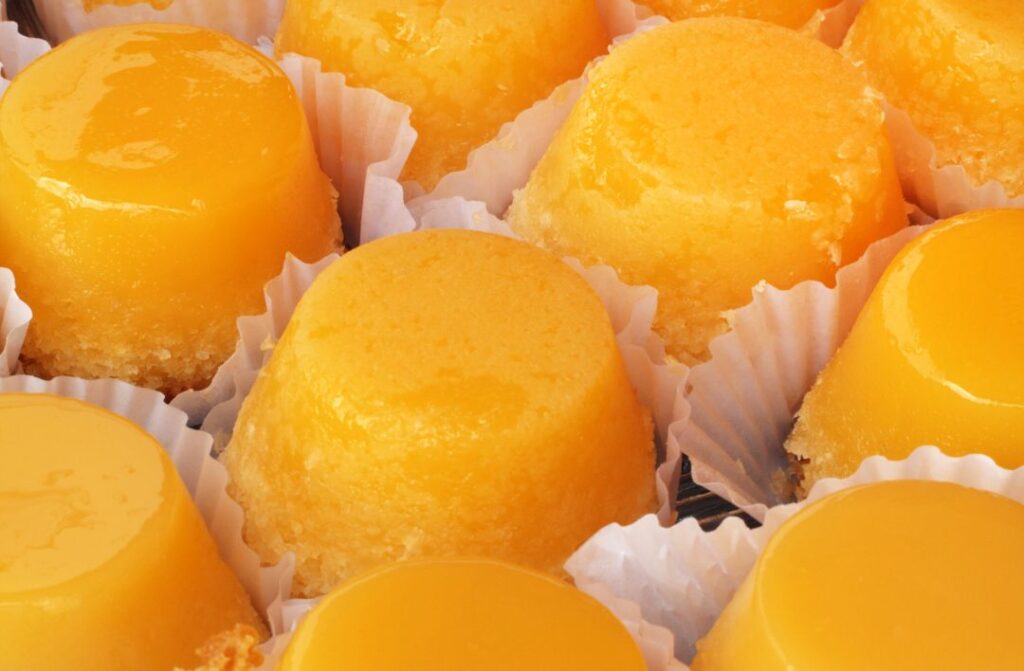
Quindim is a dessert that is either served as a large cake or in small, mouth-size portions. It’s basically like custard with coconut and is a light option for when you’re craving something sweet.
It’s easy to find at juice bars and padarias (bakeries) throughout the city, yet one of the best ones is at Confeitaria Colombo in Centro.
BEST BRAZILIAN FOOD
Paçoca
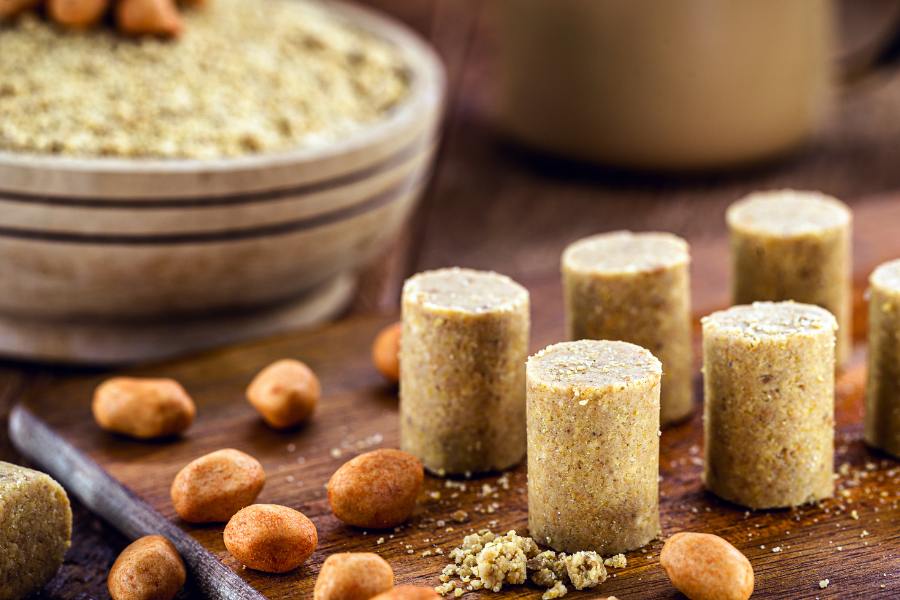
Paçoca, which is a popular Brazilian candy, has its origins in the indigenous cultures of Brazil. The word ‘paçoca’ comes from the Tupi language, meaning to crumble or to shred.
This sweet treat is typically made from a mixture of ground peanuts, sugar, and cassava flour. These ingredients are blended together until they reach a crumbly texture, then pressed into a cylindrical or square shape.
Think of the peanut-butter part of Reese’s Cup, and that is pretty much the taste of paçoca. They are so good and make great on-the-go snacks. The best place to get them are from the supermarkets, the bancas (the newsagents on the streets), or at Casa do Biscoito, which sells them in big tubs.
Brazilian Food: Frequently Asked Questions
What Is The Most Popular Food in Brazil?
The most popular food in Brazil is arguably Feijoada — the National Dish of Brazil. It is a hearty black bean stew with pork. Originating from the time of slavery in Brazil, this dish includes black beans slow-cooked with a variety of meats, often served with rice, collard greens, and farofa.
What are traditional Brazilian foods?
Traditional Brazilian foods include Feijoada, Pão de Queijo, Acarajé, Churrasco, Carne de Sol, Moqueca, Coxinha, Pastel, Brigadeiro, Açaí, and Bobó de Camarão.
What are African Brazilian foods?
African influences in Brazilian cuisine can be seen in dishes such as Acarajé, a deep-fried ball of black-eyed pea dough filled with shrimp, and Vatapá, a creamy dish made from bread, shrimp, coconut milk, and palm oil.
Other Brazilian foods with African influences include Caruru, a sauce or stew made with okra, onion, shrimp, palm oil, and nuts, and Bobó de Camarão a rich and creamy shrimp stew. These dishes reflect the culinary heritage of Afro-Brazilians, particularly from the state of Bahia
What are 3 staple foods in Brazil?
Three staple foods in Brazilian cuisine include rice, beans, and cassava. These ingredients form the backbone of many traditional Brazilian dishes and are consumed regularly across the country.
What do Brazil eat for breakfast?
For breakfast, Brazilians typically enjoy a light meal that may include pão de queijo (cheese bread), fresh fruits, bread with butter or requeijão (a creamy cheese spread), and a cup of strong coffee or café com leite (coffee with milk). Occasionally, cakes and pastries might also be part of the breakfast table.
Final Thoughts: The BEST Brazilian Foods
In the tapestry of Brazil food, you can find a kaleidoscope of flavors, textures, and traditions that beautifully illustrate the foods of Brazil. The country’s cuisine is a testament to its diverse cultural influences and regional variations, all tied together by Brazil food traditions that are cherished and preserved over generations.
Each dish Brazil has to offer, from the most humble rice and beans to the most elaborate feijoada or seafood moqueca, tells a story. These dishes, some of which have become Brazil famous food, are prepared with love and often served with a warm Brazilian smile.
Looking for a taste of Brazil at home? Brazilian recipes (and Brazilian street food recipes) are a delight to explore, offering an array of dishes to suit all taste buds. And don’t forget to include a photo when sharing your culinary creations – food is a feast for the eyes as well!
Lastly, for those with a sweet tooth, Brazil does not disappoint. A perfect example is the Passion Fruit Mousse, a deliciously sweet and tangy dessert that perfectly encapsulates the vibrant spirit of Brazilian cuisine. From the first bite to the last, the foods of Brazil truly offer a culinary journey like no other.
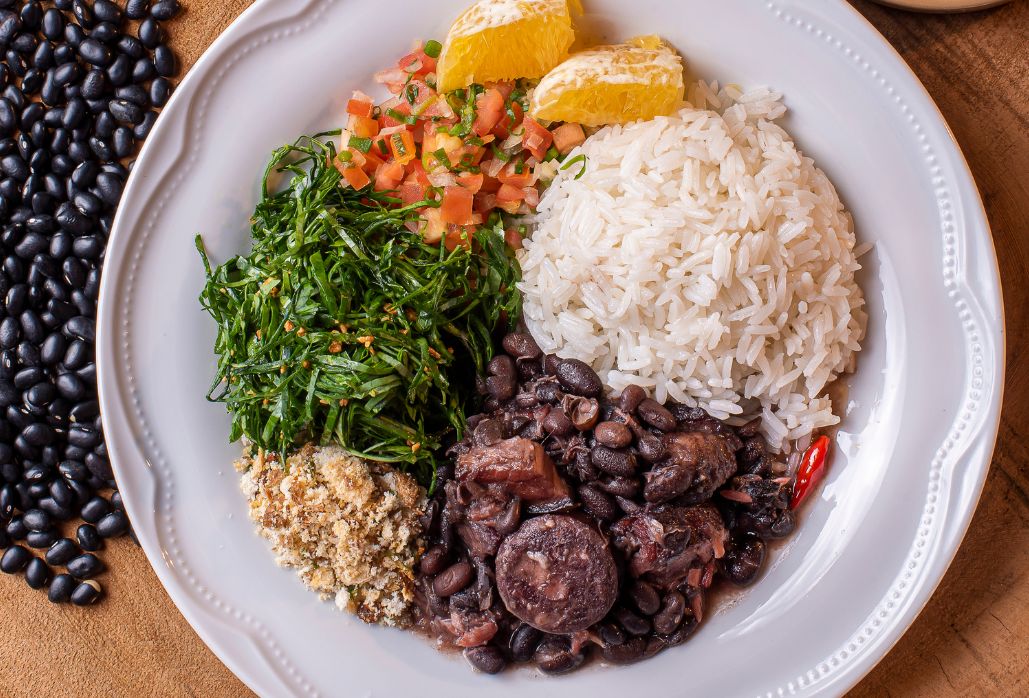
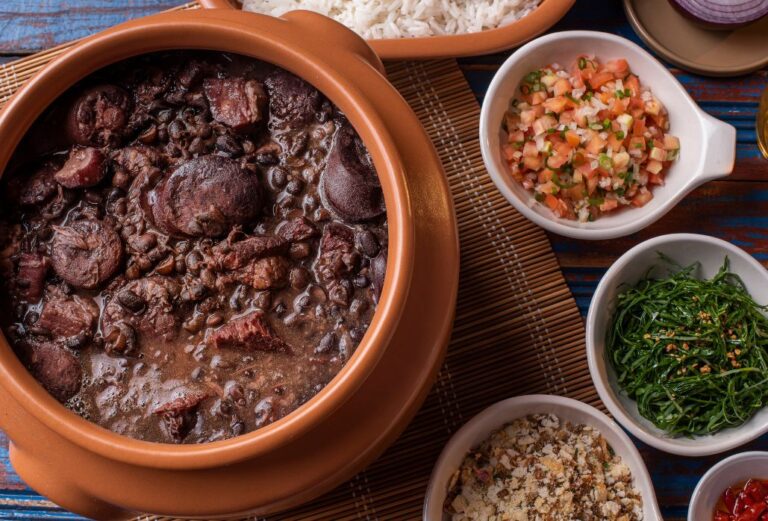
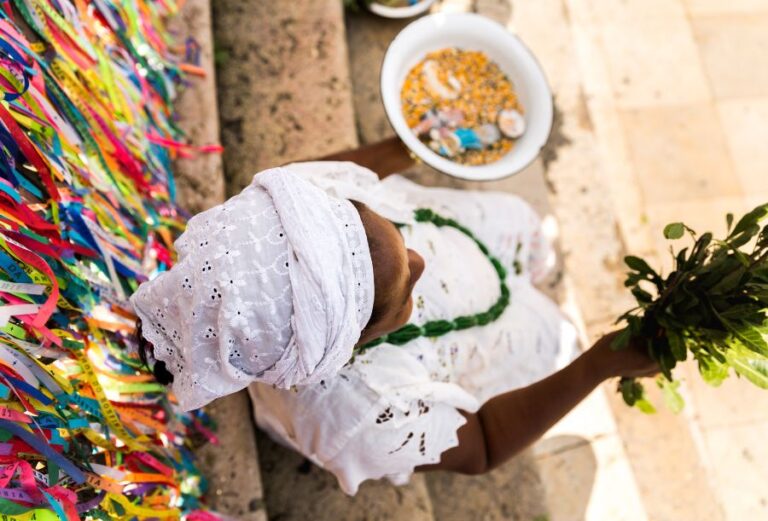



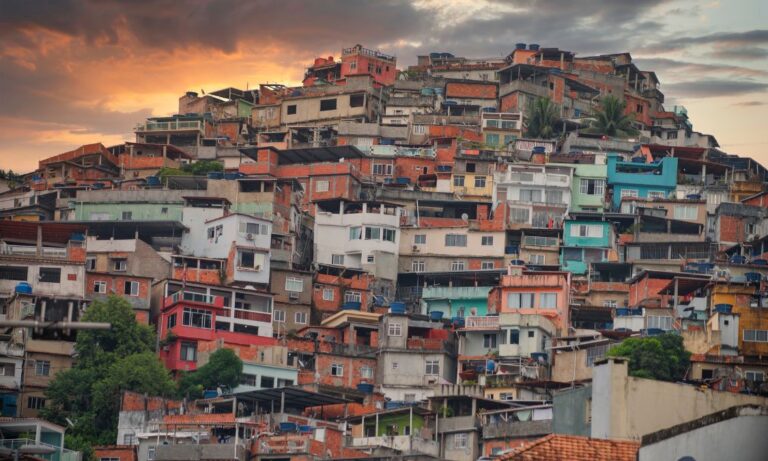
they are so RIGHT!!!!!